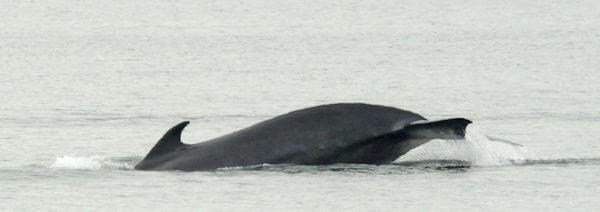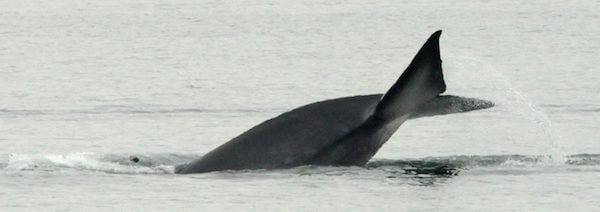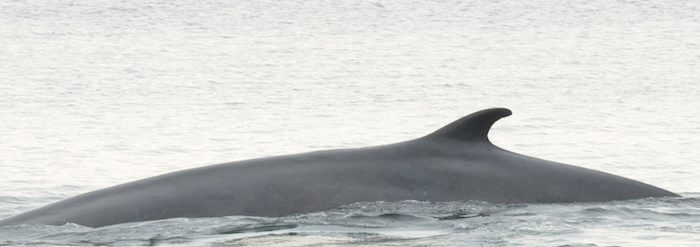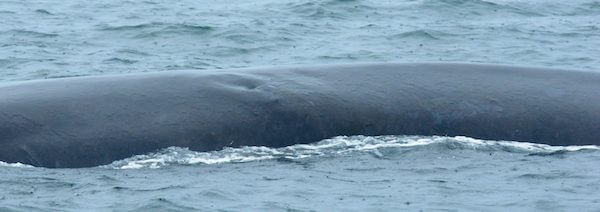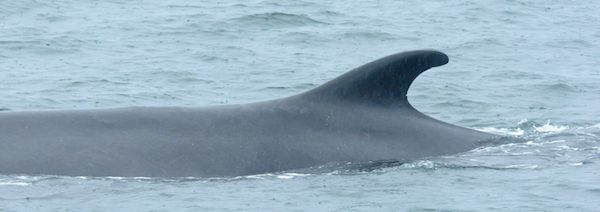Trou
Fin Whale


-
ID number
Bp059
-
Sex
Female
-
Year of birth
Unknown
-
Known Since
1994
Distinctive traits
Bp059 has been given the somewhat peculiar name of “Trou” (“hole”, in french) because of the large volcanic crater-shaped hole in the center of the protuberance marking her left flank, just behind the blowhole.
Her dorsal fin has two slight notches – one at the very top, the other at the base. In addition, her chevrons show very little contrast.
Life history
“Trou” is a known female since 1994. She is considered a seasonal resident since the average frequency of her visits to the estuary is more than three years out of four.
She was observed with a calf in 2006, 2009 and 2020. For 2006 and 2009, the number of sightings with the calf does not allow us to confirm beyond any doubt that she was the calf’s progenitor. In 2020, the observations are sufficient to confirm this. Trou is therefore possibly a mother three times!
Trou has allowed researchers to greatly increase their knowledge of fin whales. In 1996, the GREMM team attached a radio transmitter to her back, allowing them to follow her for 12 hours. This measure was one of 25 telemetric tracking operations carried out in partnership with the Saguenay-St. Lawrence Marine Park and Fisheries and Oceans Canada from 1994 to 1996. This research project aimed to study the territory used by fin whales as well as to evaluate the impact of boats on their behaviour.
Observations history in the Estuary
Years in which the animal was not observed Years in which the animal was observed
Latest news from the publications Portrait de baleines
Story of the week (By Tim Perrero)
This is the first time I’ve ever seen a fin whale swimming backward. Bp059, a.k.a. “Trou”, first showed its peduncle (the part between the dorsal fin and the tail lobes), then its dorsal fin, followed by the flank and, lastly, the blowhole. It’s as if I’m playing a breathing sequence in reverse! Accompanied by her calf, this female was the only one in the quintet to swim this way. How might we explain this strange behaviour? Hard to say… In any case, Trou is a very peculiar individual. Once, in 2016, she showed her tail when she dove, an extremely rare behaviour in fin whales.
Unfortunately, I don’t have a video! The other fin whales in the group had not yet been photographed, so we concentrated instead on taking their pictures for our photo-ID work.
Bp059, known as “Trou”(meaning “hole” in french), joined the photo identification catalog of fin whales in the Estuary in 1994.
The average frequency of her visits to the Estuary is more than three years out of four, making it a
“regular” St. Lawrence River. Some fin whales are only occasional visitors, while others remain faithful to their feeding grounds. The recurrence of her visits allows GREMM researchers to study her and learn more about her species. It must be said that Trou is easily identifiable: she owes her name to the hole in the shape of a volcanic crater on her left flank.
In 1996, thanks to a radio transmitter attached to her back, she was followed for 12 hours to study the territory used by fin whales and to evaluate the impact of boats on their behavior. In 2000, the taking of a sample of its blubber (or biopsy) reveals that Trou is a female, which suggests that the calves that accompanied her in 2006 and 2009 could be hers. A calf was also seen in her company in 2020. Repeated observations in July confirmed that it is indeed hers.
In addition to contributing to GREMM’s documentation of fin whales, Trou offers a unique show in 2016 when she plunges with its tail out. This is a very rare behaviour among fin whales.
Bp059 is nicknamed “Trou” (Translator’s note: “hole” in French) in the Marine Park due to the protuberance behind her blowhole on her left flank that resembles a volcanic crater. Her dorsal fin is marked by two notches at both ends; her chevrons show very little contrast. A biopsy taken in 2000 allowed researchers to conclude that Trou is a female. In 2006 and 2009, Trou was seen with a calf. This year again, Trou was sighted with a little one at her side. Keep your eyes peeled, as we will need to observe the calf multiple times at her side over the course of the season to confirm whether or not this offspring indeed belongs to Trou. In 1996, Trou was tracked by radio telemetry as part of a program to study fin whales’ use of the area and to evaluate the impact that boats have on their behaviour. The tag remained in place 12 hours. Trou’s frequent use of the Estuary means that she is considered a “seasonal resident”.
Like the other cetaceans of the St. Lawrence, fin whales frequent the mouth of the Saguenay to feed. They are known for their particularly impressive feeding strategies. Thanks to the use of drones and aerial observations from research groups around the world, we have a better understanding of these fascinating behaviours. We can occasionally see them execute a complete roll-over. Similar to blue whales, fin whales turn on their sides, accelerate and open their mouths by angling their lower jaws to nearly 90° to engulf a volume of water that sometimes exceeds their own volume. In fact, a fin whale’s belly, with its expandable ventral grooves, increases on average 162% in circumference and 38% in length, allowing it to take in up to 80,000 litres of water in just a few seconds. This water is then expelled through the baleen, leaving only prey trapped inside the animal’s mouth. With gulps spaced just over 40 seconds apart, this large rorqual can thus take more than one bite per dive.
The colouration of the fin whale’s jaw is asymmetrical: white on the right side and darker on the left. Some researchers hypothesize that this asymmetry might allow the animal to better camouflage itself when it is hunting large schools of fish. Others believe that fin whales use this particular trait to better disorient their schools of prey when encircling them. Hopefully we’ll have the chance to witness such displays this season!
At last, fin whales are being seen more regularly in the Marine Park! Among them was Bp059, photo-ID’d off Cap de Bon-Désir between Les Bergeronnes and the Paradis Marin campground, and later near Pointe à Pierre-Paul. Bp059 received the somewhat unusual name of “Trou” (French for “hole”) in reference to the protuberance on her left flank behind her blowhole. The cavity at the centre of the bulging outgrowth resembles the shape of a volcanic crater. Trou also has two slight notches in her arched dorsal fin and her back is marked by a discreet dip just in front of the dorsal fin. The light gray markings of her chevron are not strongly contrasting.
Fin whales may occasionally be confused with another species of the same family that sometimes frequents the area: sei whales. The sei whale is often described as a smaller version of the fin whale: 12 to 16 m versus 18 to 21 m. Unlike the fin whale, the sei whale shows no pigment asymmetry in the jaw and baleen. The back of the fin whale is slate gray, while that of the sei whale tends toward dark green, with small white dots under the belly.

This cosmopolitan species is found scattered throughout the oceans of both hemispheres; observations in the St. Lawrence are rare. Thanks to genetic analysis, Marine Mammal Emergencies was able to confirm that a sei whale carcass washed up in Baie-Comeau in 2009.
One feeding habit of the sei whale that is not found in other rorquals is that it often “skims” its prey – even if it has ventral grooves – thus filtering its food as it swims along.
Sei whales, which have been decimated by hunting, are under-studied. Encounters with these denizens of deep waters far from the coast are rare, unpredictable and brief. However, the Falkland Islands (South Atlantic) have been designated as a hot spot for the species, hence the creation in 2016 of the Sei Whale Project in the archipelago, which aims to gather data to better understand these animals.
Trou is a female fin whale that gets her less than poetic name from the protuberance behind her blowhole on her left flank, which looks a little like the crater of a volcano. This mark is her signature, making her easily recognizable. Other less obvious features also help to identify this individual: a very pale chevron compared to other fin whales, a depression in front of the dorsal fin that breaks the continuous line of her back, and two discreet notches on her rather curved dorsal fin.
Last week, groups of fin whales off Ile Verte were feeding. They are not regularly seen in this area. These animals were probably attracted by the abundance of food – sand lance, according to studies by the Parks Canada team. We know that whales come to feed in the cold waters of the river. But what about the whales’ prey this year? The conservation team at the Saguenay-St. Lawrence Marine Park (SSLMP) reports an intense start to the season, with dense schools of fish in the Haut-fond Prince lighthouse area in May and June. Between late July and early August, they were able to record krill for the first time this season. This corresponds exactly to observations of blue whales, which feed almost exclusively on this prey! It was mainly Arctic krill, one of the two species of krill that can be found in the St. Lawrence Estuary, and it was found within 40 m of the surface. Very few krill have been observed in the Marine Park over the past two years. An acoustic mission led by Dr. Yvan Simard (DFO-IML and ISMER) is taking place aboard the Alliance in the Saguenay Fjord until August 26. The study will enable us to learn more about sound propagation in this area.
Trou owes her name to a huge depression surrounded by a blister behind her blowhole on the left side. On her right side, less spectacular characteristics are used to identify her: a rather curved dorsal fin with two quite discrete notches; another depression in front of her dorsal fin breaks the continuous line of her back. Trou lacks the contrasting chevron present in most fin whales.
This year, she was seen for the first time by the GREMM team on June 11. After disappearing from the Marine Park for some time, she reappeared on August 11.
Trou is considered a seasonal resident of the Estuary, as she has been seen more than three quarters of the years since she was first observed in 1994.
Trou was spotted with a calf in 2006 and in 2009, though it is not possible to determine the existence of kinship between them. This three-year interval corresponds well however to the minimum time span between births in fin whales. After a gestation period of 11 to 12 months, calves are born between November and January. The newborn weighs nearly 2 t and measures over 6 m. It is nursed by its mother for 6 to 7 months. Once weaned, the young sometimes seeks the company of an adult, though not necessarily that of its mother.
In winter, fin whales of the North Atlantic – including those individuals that frequent the St. Lawrence – set out for temperate waters to reproduce. Their calving grounds, which are certainly farther south in the ocean, are poorly known, as are their migratory movements. These solitary animals form temporary associations in pairs or in groups. In the 1980s and 90s, groups of several dozen fin whales (up to 40 individuals) were observed in the Estuary.
Since 1986 the GREMM has been managing a catalogue of fin whales of the Estuary, which contains approximately 100 individuals. Fin whales identified in the Gulf – about 450 individuals – have been catalogued by MICS since 1980. In Canada, the conservation status of the fin whale is “Special Concern”.
Video of a breathing sequence of a group of fin whales.
A fin whale with an evocative, if rather unpoetic, name, Trou is easily recognized by the enormous depression and puffiness on the back of her head, on the left side. More discreet on the right, she can still be identified, especially in photographs, by two slight notches on the trailing edge of her dorsal fin, one at the very top and the other at the base.
Hole is a female, as a biopsy revealed. A regular visitor to the Saguenay-St. Lawrence Marine Park, she has been recorded since 1994. This year, she has been regularly photographed in the area since July 16.
Fin whale identification reveals the faces of the whales and tells their individual stories: an added value when observing these animals! It’s also a scientific tool of choice for tracking this herd, which has enabled a whale-watching-based tourism industry to flourish in the region. This work has highlighted the importance of the Marine Park as a whale-feeding destination, with a regular herd of animals returning year after year to stay for several weeks. Systematic photo-identification allows us to characterize the animals’ residency patterns and generate abundance indices that are comparable from one year to the next. A unique environment, a changing environment, an environment that needs to be understood so that it can be cared for responsibly: it’s for these reasons that the Eco Whale Fund, to which tour operators who are members of the Eco Whale Alliance contribute, is supporting GREMM’s photographic survey of the rorqual whales in the Marine Park.
Second largest whale in the world, the fin whale occupies all oceans from pole to pole, and is also present in the Mediterranean. It is the species that has been hunted the most in the 20th century, with 725,000 taken in the Southern Hemisphere and probably close to 100,000 in the Northern Hemisphere. Iceland and Japan still hunt this species.
The large hole on her back, behind the blowhole on the left side, is the origin of the name of this female fin whale, known since 1994 (code Bp059) and spotted several times since August 2, notably off Les Escoumins. Trou can also be recognized by the large depression in front of her dorsal fin, the subtle notch at the top of her dorsal fin and her low-contrast chevron. Considered a “seasonal resident”, she returns to the St. Lawrence more than three years out of four, so it’s hardly surprising that in 2011 she was seen in the company of Capitaine Crochet and U2, two other regulars.
Trou was occasionally seen with a youngster in 2006 and 2009, though it’s unclear whether they were really related. Why don’t we see more adult-young pairs here? Relatively little is known about reproduction in this species, although past hunting data suggest that females give birth in winter to a calf every two or three years, after a gestation period of 11 to 12 months. The young remain with their mothers for six to eight months. Fin whale mothers, having given birth early in winter and arriving late in the estuary, may already have weaned their calves and be seen alone. Once weaned, fin whale calves sometimes seek adult company, but not necessarily their mothers.
Fin whales come to the cold, rich St. Lawrence to gorge themselves on herring, capelin and krill, whether solo, in pairs or in groups of three to over twenty, depending on the tides: tightly packed on the way up and dispersed on the way down.


